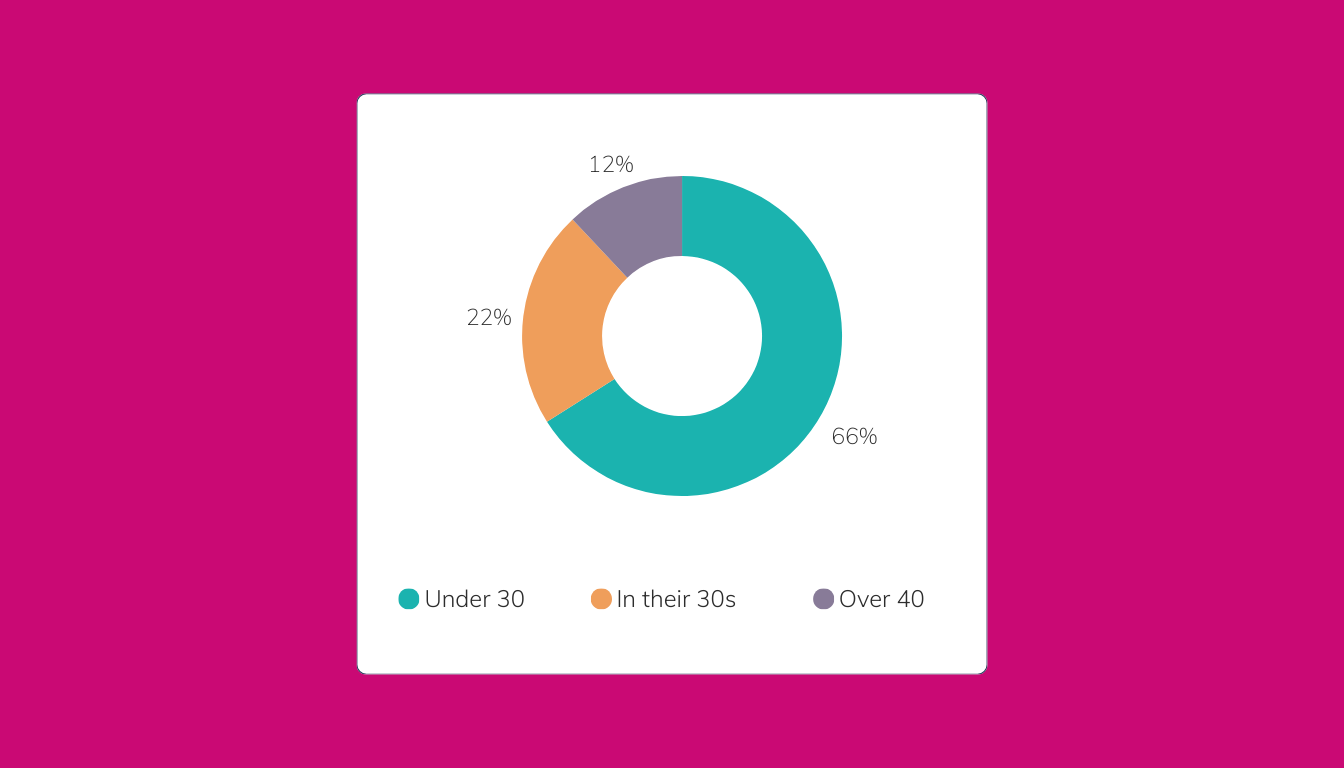Shared living is not just for students
The idea that shared housing is only for students or twenty-somethings is outdated. Our survey shows a clear shift: tenants in their 30s and 40s are now a growing share of the shared living market.
- 66% of tenants are under 30
- 22% are in their 30s
- 12% are over 40
This is a group that rarely gets targeted, and yet it is growing steadily.
Where this shift is happening
Southampton came out on top as the over-40s shared housing hotspot, with just over 20% of this group.
London followed closely at 19.8%, with other cities including Leeds, Manchester, Portsmouth and Coventry also showing notable numbers.
These are not isolated cases. They reflect a wider shift in who shared housing is for.
Why tenants in their 30s and 40s are choosing shared living
For many people in their 30s and 40s, the traditional route of buying a home has become increasingly difficult. Rising house prices, higher living costs and a tougher job market mean that ownership is out of reach for a growing share of this generation.
Shared living provides a practical alternative. It allows tenants to:
- Stay connected to city life. Jobs, culture and social networks are often concentrated in urban areas. Shared housing makes these locations affordable in a way that solo renting does not.
- Keep flexibility and choice. Compared with being locked into a mortgage or an expensive one-bed flat, shared living gives tenants more options and the ability to adapt as their circumstances change.
- Maintain the lifestyle they want. Many tenants in their 30s and 40s are unwilling to compromise on quality of life. Shared living allows them to live closer to work, cut commuting time, and remain part of active, connected communities.
This shift reflects more than just economics. It is a lifestyle choice shaped by experience. This generation has lived through recessions, financial instability and rising costs, and many now view flexibility as just as valuable as ownership.
Shared living gives them exactly that balance: affordability without isolation, independence with community, and stability without being tied to one option.
What this means for property managers
Property managers who still treat shared housing as a student-only market are overlooking a valuable opportunity. Tenants in their 30s and 40s now make up a significant, and growing, part of the sector. This is a demographic with different needs, expectations and priorities than younger tenants.
Recognising and catering to this group means thinking beyond the basics. Homes that appeal to tenants in their 30s and 40s should be designed and managed with stability in mind. That might include clearer household structures, better communication systems, higher-quality fixtures, and spaces that feel more like permanent homes rather than temporary stopgaps.
This group is often older, more settled, and focused on balancing affordability with quality of life. They want homes that are well run, well maintained, and compatible with their lifestyle. Property managers who can meet those expectations will be better positioned to retain tenants for longer and reduce costly voids.
Most importantly, this is not a passing trend. The shift towards older tenants choosing shared living reflects a long-term change in the housing market and in how people view shared housing.
Those who adapt now will be well placed to serve a growing, and often underestimated, part of the market.
FAQs about tenants in shared living
Is shared living just for young people?
No. 22% of shared living tenants are in their 30s and 12% are over 40.
Which cities have the most over-40 tenants in shared housing?
Southampton leads, followed by London, Leeds, Manchester, Portsmouth and Coventry.
Why are older tenants choosing shared living?
Rising housing costs, limited access to homeownership, and the desire to stay in cities where work and culture are accessible.
What should property managers do?
Recognise this untapped market, and design homes that provide stability, affordability and community for tenants beyond their 20s.
👉 Want more insight into the changing shared living market? Download the State of Shared Living 2025 report to explore the full data.
Shared living is not just for students
The idea that shared housing is only for students or twenty-somethings is outdated. Our survey shows a clear shift: tenants in their 30s and 40s are now a growing share of the shared living market.
- 66% of tenants are under 30
- 22% are in their 30s
- 12% are over 40
This is a group that rarely gets targeted, and yet it is growing steadily.
Where this shift is happening
Southampton came out on top as the over-40s shared housing hotspot, with just over 20% of this group.
London followed closely at 19.8%, with other cities including Leeds, Manchester, Portsmouth and Coventry also showing notable numbers.
These are not isolated cases. They reflect a wider shift in who shared housing is for.
Why tenants in their 30s and 40s are choosing shared living
For many people in their 30s and 40s, the traditional route of buying a home has become increasingly difficult. Rising house prices, higher living costs and a tougher job market mean that ownership is out of reach for a growing share of this generation.
Shared living provides a practical alternative. It allows tenants to:
- Stay connected to city life. Jobs, culture and social networks are often concentrated in urban areas. Shared housing makes these locations affordable in a way that solo renting does not.
- Keep flexibility and choice. Compared with being locked into a mortgage or an expensive one-bed flat, shared living gives tenants more options and the ability to adapt as their circumstances change.
- Maintain the lifestyle they want. Many tenants in their 30s and 40s are unwilling to compromise on quality of life. Shared living allows them to live closer to work, cut commuting time, and remain part of active, connected communities.
This shift reflects more than just economics. It is a lifestyle choice shaped by experience. This generation has lived through recessions, financial instability and rising costs, and many now view flexibility as just as valuable as ownership.
Shared living gives them exactly that balance: affordability without isolation, independence with community, and stability without being tied to one option.
What this means for property managers
Property managers who still treat shared housing as a student-only market are overlooking a valuable opportunity. Tenants in their 30s and 40s now make up a significant, and growing, part of the sector. This is a demographic with different needs, expectations and priorities than younger tenants.
Recognising and catering to this group means thinking beyond the basics. Homes that appeal to tenants in their 30s and 40s should be designed and managed with stability in mind. That might include clearer household structures, better communication systems, higher-quality fixtures, and spaces that feel more like permanent homes rather than temporary stopgaps.
This group is often older, more settled, and focused on balancing affordability with quality of life. They want homes that are well run, well maintained, and compatible with their lifestyle. Property managers who can meet those expectations will be better positioned to retain tenants for longer and reduce costly voids.
Most importantly, this is not a passing trend. The shift towards older tenants choosing shared living reflects a long-term change in the housing market and in how people view shared housing.
Those who adapt now will be well placed to serve a growing, and often underestimated, part of the market.
FAQs about tenants in shared living
Is shared living just for young people?
No. 22% of shared living tenants are in their 30s and 12% are over 40.
Which cities have the most over-40 tenants in shared housing?
Southampton leads, followed by London, Leeds, Manchester, Portsmouth and Coventry.
Why are older tenants choosing shared living?
Rising housing costs, limited access to homeownership, and the desire to stay in cities where work and culture are accessible.
What should property managers do?
Recognise this untapped market, and design homes that provide stability, affordability and community for tenants beyond their 20s.
👉 Want more insight into the changing shared living market? Download the State of Shared Living 2025 report to explore the full data.








